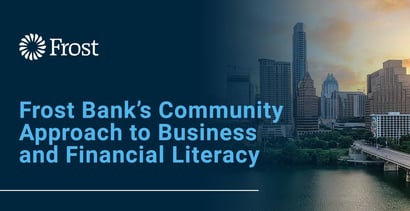

In a Nutshell: Frost Bank strives to bolster its business practices and help people break through the stigma of financial illiteracy with its community outreach. By developing courses for small businesses and youth programs, Frost Bank is achieving its goals and dispelling the misconception that large banks don’t prioritize customer service. At a time when many banks are moving further from personal attention, Frost is creating its own path for business development by catering to customer needs and understanding the financial uncertainties many people go through.
One might say Frost Bank’s customer-centric approach is unconventional for a publicly traded company with $50 billion in assets and over 150 financial centers across the state of Texas. Few people could have envisioned how far Frost Bank would come from its humble beginnings and emphasis on customer satisfaction and relationship building.
The bank got its start in 1868 as a mercantile enterprise operated by its founder, T.C. Frost, who assisted ranchers in San Antonio with their wool trade. At the time, wool producers would flood the market with wool at the same time of year causing prices to plummet. Frost’s solution was to store the wool in his warehouse and give wool producers credit. When the value of wool went back up, the ranchers would sell it at a higher price and pay Frost back. It was a service to the community that proved to be quite lucrative and led to what Frost Bank has become today.
The 150-year-old company still takes pride in building long-term relationships with its clients. In fact, its 24-hour customer care line sidesteps call trees or complex automation and puts customers directly in contact with bankers who are available to speak with them.
Bill Day, Senior Vice President of Corporate Communications at Frost Bank, said he believes that listening to the needs of the customers and doing whatever is necessary to help them grow and prosper is fundamental to the company’s success.
It’s an attitude that reflects on the company’s efforts to expand its physical footprint.
As other banks continue to reduce their brick-and-mortar branches and go digital, Frost is taking the opposite approach. Customers respond positively to having locations that are nearby. In fact, the bank has noticed that many of its small business accounts are opened within five miles from a physical location. As Day describes it, “Because it’s important to customers, it’s going to be important to us.”
While it would be more convenient and affordable for the company to focus solely on online channels, Frost still insists on the principle of placing its customers’ values first. “It’s customer-centric, relationship-centric, and community-centric,” Day said.
Small Business Support and Access to Banking
Considering its strong focus on customer needs, it’s no surprise that Frost Bank believes in giving back to the communities it serves. That stance also falls in line with Frost’s participation in the Community Reinvestment Act, which encourages financial institutions to address the credit needs of their communities, particularly in low- and moderate-income neighborhoods.
To improve financial literacy, Frost Bank has cultivated a leading presence in communities through its educational program, garnering requests from non-profits, schools and small business entities on a regular basis.

Frost Bank’s Senior Vice President and CRA officer, Donna Normandin, said that the company’s approach to education — small in-person audiences — really helps participants feel comfortable when dealing with issues like financial literacy.
One of the core groups that benefit from the program are small businesses. While working with local entities, Normandin and her team will sometimes partner with microlenders who can help make loans to customers who are not quite bankable yet.
Other ways Frost Bank provides assistance is through seminars, local business development centers, contractors’ associations and other organizations that ask Frost to develop business modules for their clientele. Key to the program’s success is how Frost tailors the classes according to the needs of the participants. “We really try to understand what it is that they’re looking for and then mold what we do,” said Normandin.
Once a year, the company also hosts a four-week small business series it started in 2017, and which now draws over 400 businesses. It’s an intensive program some have light-heartedly likened to bootcamp for small business banking. A unique aspect of the program is that Frost will hire experts — including small business bankers — to teach the classes and target the appropriate audience. At the end of the series, Frost will provide various tools, such as laptops or QuickBooks programs, that can help these businesses with their operations.
Programs for Youth Financial Literacy
On the consumer side, Frost Bank offers financial literacy outreach classes for children, adults, and seniors. The classes are particularly beneficial to public school students because the state of Texas requires children to perform annual financial literacy testing.
In fact, Frost regularly receives calls from teachers and administrators to assist them with finance curriculum, whether it be to teach the teachers about financial literacy or have Frost’s experts come to the classroom and teach students directly.
Meanwhile, an eight-month course for schools called Frost Financial Youth Academy teaches students different modules of banking. Normandin noted that the whole idea behind the academy is to prepare students before they hit financial pitfalls in life. Since its inception in 2005, the academy has been successful and much in demand in the community. It even hands out scholarships at the end of every year.
The company also holds events during reality fairs at high schools and colleges, where students assume real-life scenarios. Students are given a set of conditions, like being married with two children, and then asked to develop a budget. Students learn about mortgages and other real issues. These school events were disrupted at the start of the pandemic.
But Frost Bank moved its educational initiative online and continues to provide service virtually to local communities.
Fortunately, as lockdowns continue to be lifted and children go back to school, Frost is starting to provide in-person classes again. “I think virtual is great for some things, but it’s not so great for education. So I’m really glad about that, and for us to really be able to get out more,” added Normandin.
Building Relationships by Connecting with Customers
Frost Bank emphasizes making bank services, like opening a checking account, readily accessible to prospective clients whether they be small businesses or individual consumers.
“We always point them to a branch where they can go in and open an account if they wish, and sometimes we are able to open the account on site, depending on where we are,” said Normandin, with the goal being that opening an affordable account should be as easy as possible.

Customer confidence has played a major role at Frost Bank in establishing long-term connections, and the bank knows that building trust begins not only with comfort, but also awareness. Once people have more knowledge about a specific subject, their confidence grows and they no longer have to rely so much on the word of others.
One of Frost Bank’s goals is to help clients a little bit so they can go in the right direction. Gaining knowledge about why NSFs and overdrafting are detrimental and how to avoid these missteps can be empowering.
Those are the milestones Normandin said she really enjoys. “It’s those a-ha moments for people. That’s what I love. And they have a moment when you can see something is clicking,” said Normandin. “That’s the best thing.”
Advertiser Disclosure
BadCredit.org is a free online resource that offers valuable content and comparison services to users. To keep this resource 100% free for users, we receive advertising compensation from the financial products listed on this page. Along with key review factors, this compensation may impact how and where products appear on the page (including, for example, the order in which they appear). BadCredit.org does not include listings for all financial products.
Our Editorial Review Policy
Our site is committed to publishing independent, accurate content guided by strict editorial guidelines. Before articles and reviews are published on our site, they undergo a thorough review process performed by a team of independent editors and subject-matter experts to ensure the content’s accuracy, timeliness, and impartiality. Our editorial team is separate and independent of our site’s advertisers, and the opinions they express on our site are their own. To read more about our team members and their editorial backgrounds, please visit our site’s About page.




